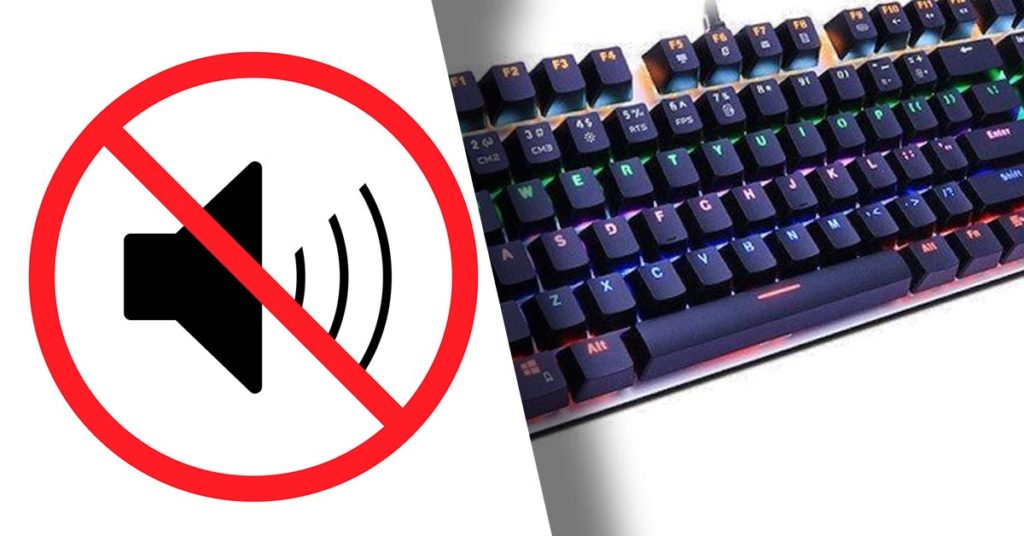
One possible downside of owning a mechanical keyboard is the noise that they produce. A lot of factors such as rattling stabilizers and switch type can cause your keyboard to be loud. However, there are some simple modifications you can do to make your keyboard sound quieter and more pleasant.
To make a mechanical keyboard quieter, you can lube your switches, replace your switches with a quieter switch, or install O-Rings. Additionally, you can install foam or silicone inside your keyboard to act as a dampener and you can use a desk mat to absorb the sound produced by your keyboard.
In this article, we will be talking about the modifications that you can do with your keyboard in more detail. We will also give you some tips in case your keyboard is not easily modifiable. Keep on scrolling to know how to get rid of any unwanted noise in your keyboard.
Why are Mechanical Keyboards So Loud?
When you get a mechanical keyboard, you ditch the normal keyboard rubber dome that actuates every key you press in a membrane keyboard. Instead, you jump into the world of switches, where put, you push down a key to the bottom, you are pushing plastic that meets with more plastic to actuate a key, that physical contact between the two surfaces is where the sound comes from.
This noise comes from every type of switch, whether clicky, tactile, or linear, because they are all plastic that hits a bottom plastic surface at the end of the day. It’s worth mentioning that if what you have are clicky switches, those will be another reason for the loud sounds every press of a key makes.
Do you have to sacrifice everything a mechanical keyboard has to offer and go back to a membrane one to get the silence you are seeking for? Absolutely not. A normal keyboard has a rubber dome under every key, which is what makes them quiet every time you press its keys because they aren’t having contact with another hard surface. While we can’t have that same rubber dome in our mechanical keyboards, there are some things we can swap, add, or even modify to work to our advantage to significantly lessen the loudness every push of a button emits.
What Can You Do To Reduce the Noise?
Changing your current switches: First of all, we gotta take a peek under the hood. What type of switches do you use? If your answer is clicky, then you should already know that these were made with the intent of having a loud click sound.
You have some options depending on your preferences:
- Switch to a Tactile switch, which could be an MX Brown or MX Clear. This will still leave you with the tactile bump you feel whenever you are pressing a key on a clicky switch keyboard but will cancel the noisy clicks since these are built to be quieter than the loud Clicky switches. The only difference between the MX Brown and MX Clear is that the Clear needs a heavier push to actuate the key.
- Switch to a Linear switch, which could be an MX Red or MX Black. These are known for their smoothness in every push of a button, which means no tactile bump like the one other switches offer. But they are known to be the most silent out of the three types of switches since they were designed to be one of its purposes. Same as above, the difference between the MX Red and MX Black is that the Black needs a heavier push to actuate a key.
To know which type you would like to change to, I recommend you get yourself a switch tester, giving you the chance to see how every single type and color of switches feels in terms of smoothness/bumps and loud/quieter click sound. You can find many good ones available online.
But what if you already have Linear switches? Keep reading because I have an interesting find that I want to share with you!
The Cherry “Silent” MX Red and MX Black Switches
Yes, the quiet switches just got quieter. The company Cherry (which originally made the shape of the most commonly known switches) has come up with even better Linear switches that are, as they claim, 30% quieter than the normal MX Red or MX Black.
This is due to an improvement in the mechanism inside of the switch, like the stem, which has noise reduction technology inside of it. These switches will improve the already most “silent” switches of them all. They are available in Black as well if you are into heavier pressing buttons.
What To Do If You Can’t Replace Your Switches?
Whether you are a typist that loves the way your Clicky switches feel, or a normal user of Tactile switches, or even a gamer with Linear switches (yes, as stated above, even it being the most silent of all the three types, Linear still produce some noise when pressing keys), and changing your switches just for the sound they make isn’t an option for you, some solutions will help fix the one thing that we are all here looking to fix, a noisy keyboard.
O Rings
As its name implies, O Rings are O-shaped rings that are made of either silicone or rubber. This is one of our favorite mods because all you have to do is take off your keys, place the rings inside of your keys, and press them back into the keyboard to set everything together. You can find them online, and they come in packages with a bunch of rings and a key remover if you didn’t already have one.
There is a significant change in the noise of any keyboard that uses these because the rings will absorb force from that contact that the key makes with the bottom surface every time it’s pressed to input a button, making the noise less noticeable.
Lubing Switches
Lubing your switches not only it improves the feel and smoothness of every push of a button, but lubing is mostly used to silence or make your keyboard quieter. To do this, you need to open every switch because we are working inside them. You can use specialized devices designed to open up switches without a hassle, or you can use a flat head screwdriver to separate the top and bottom of a switch carefully.
Once you have your switch open and have a tool to brush your lube with (a small painting brush is perfect for this job), begin by lubing the slider columns, making sure there is enough on every surface inside of it, try to not go overboard with how much lube you use, start small, then if more is needed to apply. After that, we move on to the spring, brush both ends with lube and place it back onto the previously lubed piece.
Then we go to the stem, make sure there is a tiny amount of lube on your tool and go ahead and lightly brush the sides of the stem, then brush the front (brush the legs if your switch is Linear, but don’t if it’s Tactile or Clicky), then lightly coat the back, and finally lube the bottom edges of the stem. After that, just reassemble, and you will have your first lubed switch done! Keep going with the rest and always make sure to start slow and small on the lube, and if you see a need for more, you can easily add a little more.
Quick Fixes
I got two tips for you if you don’t want to take any of the suggestions above just yet.
- You can use a Desk Mat under your keyboard. That will help absorb the vibration of the contact between the keys and their bottom every time they are pressed, which takes most of that noise into the mat, providing you with a noticeable difference in the noise your keys make. All you need to do is find a good Desk Mat that fits your desk. There is a wide variety found online.
- You can place a foam inside your keyboard (the very bottom). Yeah, this one sounds weird, but just like a Desk Mat, this will help absorb the vibration but from within. All you need is quality foam (that you have either laying around or you can find some online), screwdrivers to open up the keyboard and get through it, and scissors to cut and shape the foam properly to fit the inside of your keyboard. After it’s done, put everything back in place, and you should be left with less noise coming out of your keyboard.
Summary
- If you have a noisy keyboard but are using Clicky switches, try switching to either Tactile or Linear switches to see a drastic change in the amount of sound that the keys make.
- If you already have Linear switches and are up for switching to even quieter ones, take a look at the Silent MX Red or MX Black switches.
- If changing switches is not an option for you, try O Rings to put under your keycaps for a significant difference in sound, or try lubing your switches for a much smoother and quieter keyboard.
- If you want to skip all the hard work that is needed for all the suggestions presented above, or you may be trying them later but want a quick, easier fix, try getting yourself a quality Desk Mat that will absorb the vibrations coming from the keyboard every time you work on it so that they go into the mat, and not the table producing more noise, this will give you a significant change. You can also opt for placing a foam inside your keyboard to have a similar effect but not as significant.
- And if you want, you could even stack a few of these tips on top of each other to give yourself the quietest keyboard you can ever have in your hands. So whether it’s you that finds the noise annoying, your family, or your coworkers, you will be able to get rid of it with these tips and make whoever hates it happy.

The KBE team is dedicated to sharing our knowledge and creating useful resources about computer keyboards. This article was written as a team collaboration, combining our knowledge and years of experience using, building and modding keyboards. Meet the team here.



